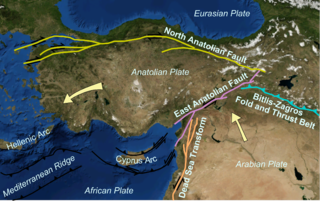- East Anatolian Fault
-
The East Anatolian Fault is a major strike-slip fault zone in eastern Turkey. It forms the transform type tectonic boundary between the Anatolian Plate and the northward-moving Arabian Plate. The difference in the relative motions of the two plates is manifest in the left lateral motion along the fault. The East and North Anatolian faults together accommodate the westward motion of the Anatolian Plate as it is squeezed out by the ongoing collision with the Eurasian Plate.
The East Anatolian Fault runs in a northeasterly direction, starting from the Maras Triple Junction at the northern end of the Dead Sea Transform, and ending at the Karliova Triple Junction where it meets the North Anatolian Fault.
From 1939 to 1999 a series of earthquakes progressed westwards along the North Anatolian Fault. But since 2003 there have been a series on the East Anatolian Fault. These started with the 2003 Bingöl earthquake and include the 2010 Elâzığ earthquake.[1]
References
- ^ Zukerman, Wendy (24 October 2011). "Turkey earthquake reveals a new active fault zone". New Scientist. http://www.newscientist.com/article/dn21083-turkey-earthquake-reveals-a-new-active-fault-zone.html. Retrieved 25 October 2011.

This tectonics article is a stub. You can help Wikipedia by expanding it.

